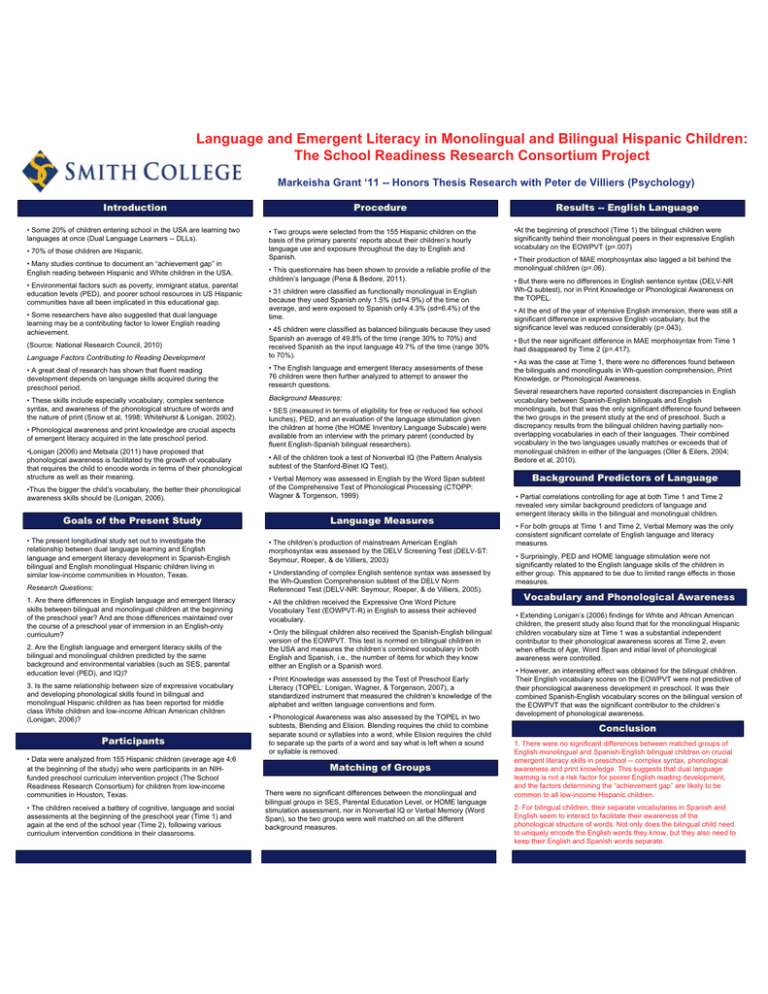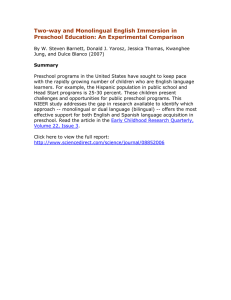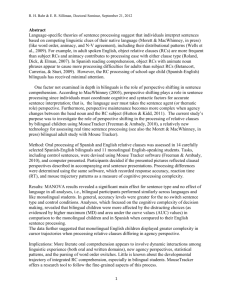Language and Emergent Literacy in Monolingual and Bilingual Hispanic Children:
advertisement

Language and Emergent Literacy in Monolingual and Bilingual Hispanic Children: The School Readiness Research Consortium Project Markeisha Grant ‘11 -- Honors Thesis Research with Peter de Villiers (Psychology) Introduction • Some 20% of children entering school in the USA are learning two languages at once (Dual Language Learners -- DLLs). • 70% of those children are Hispanic. • Many studies continue to document an “achievement gap” in English reading between Hispanic and White children in the USA. • Environmental factors such as poverty, immigrant status, parental education levels (PED), and poorer school resources in US Hispanic communities have all been implicated in this educational gap. • Some researchers have also suggested that dual language learning may be a contributing factor to lower English reading achievement. Procedure • Two groups were selected from the 155 Hispanic children on the basis of the primary parents’ reports about their children’s hourly language use and exposure throughout the day to English and Spanish. • This questionnaire has been shown to provide a reliable profile of the children’s language (Pena & Bedore, 2011). • 31 children were classified as functionally monolingual in English because they used Spanish only 1.5% (sd=4.9%) of the time on average, and were exposed to Spanish only 4.3% (sd=6.4%) of the time. Language Factors Contributing to Reading Development • 45 children were classified as balanced bilinguals because they used Spanish an average of 49.8% of the time (range 30% to 70%) and received Spanish as the input language 49.7% of the time (range 30% to 70%). • A great deal of research has shown that fluent reading development depends on language skills acquired during the preschool period. • The English language and emergent literacy assessments of these 76 children were then further analyzed to attempt to answer the research questions. • These skills include especially vocabulary, complex sentence syntax, and awareness of the phonological structure of words and the nature of print (Snow et al, 1998; Whitehurst & Lonigan, 2002). Background Measures: (Source: National Research Council, 2010) • Phonological awareness and print knowledge are crucial aspects of emergent literacy acquired in the late preschool period. •Lonigan (2006) and Metsala (2011) have proposed that phonological awareness is facilitated by the growth of vocabulary that requires the child to encode words in terms of their phonological structure as well as their meaning. •Thus the bigger the child’s vocabulary, the better their phonological awareness skills should be (Lonigan, 2006). Goals of the Present Study • The present longitudinal study set out to investigate the relationship between dual language learning and English language and emergent literacy development in Spanish-English bilingual and English monolingual Hispanic children living in similar low-income communities in Houston, Texas. Research Questions: 1. Are there differences in English language and emergent literacy skills between bilingual and monolingual children at the beginning of the preschool year? And are those differences maintained over the course of a preschool year of immersion in an English-only curriculum? 2. Are the English language and emergent literacy skills of the bilingual and monolingual children predicted by the same background and environmental variables (such as SES, parental education level (PED), and IQ)? 3. Is the same relationship between size of expressive vocabulary and developing phonological skills found in bilingual and monolingual Hispanic children as has been reported for middle class White children and low-income African American children (Lonigan, 2006)? Participants • Data were analyzed from 155 Hispanic children (average age 4;6 at the beginning of the study) who were participants in an NIHfunded preschool curriculum intervention project (The School Readiness Research Consortium) for children from low-income communities in Houston, Texas. • The children received a battery of cognitive, language and social assessments at the beginning of the preschool year (Time 1) and again at the end of the school year (Time 2), following various curriculum intervention conditions in their classrooms. • SES (measured in terms of eligibility for free or reduced fee school lunches), PED, and an evaluation of the language stimulation given the children at home (the HOME Inventory Language Subscale) were available from an interview with the primary parent (conducted by fluent English-Spanish bilingual researchers). • All of the children took a test of Nonverbal IQ (the Pattern Analysis subtest of the Stanford-Binet IQ Test). • Verbal Memory was assessed in English by the Word Span subtest of the Comprehensive Test of Phonological Processing (CTOPP: Wagner & Torgenson, 1999) Language Measures • The children’s production of mainstream American English morphosyntax was assessed by the DELV Screening Test (DELV-ST: Seymour, Roeper, & de Villiers, 2003) • Understanding of complex English sentence syntax was assessed by the Wh-Question Comprehension subtest of the DELV Norm Referenced Test (DELV-NR: Seymour, Roeper, & de Villiers, 2005). • All the children received the Expressive One Word Picture Vocabulary Test (EOWPVT-R) in English to assess their achieved vocabulary. • Only the bilingual children also received the Spanish-English bilingual version of the EOWPVT. This test is normed on bilingual children in the USA and measures the children’s combined vocabulary in both English and Spanish, i.e., the number of items for which they know either an English or a Spanish word. • Print Knowledge was assessed by the Test of Preschool Early Literacy (TOPEL: Lonigan, Wagner, & Torgenson, 2007), a standardized instrument that measured the children’s knowledge of the alphabet and written language conventions and form. • Phonological Awareness was also assessed by the TOPEL in two subtests, Blending and Elision. Blending requires the child to combine separate sound or syllables into a word, while Elision requires the child to separate up the parts of a word and say what is left when a sound or syllable is removed. Matching of Groups There were no significant differences between the monolingual and bilingual groups in SES, Parental Education Level, or HOME language stimulation assessment, nor in Nonverbal IQ or Verbal Memory (Word Span), so the two groups were well matched on all the different background measures. Results -- English Language •At the beginning of preschool (Time 1) the bilingual children were significantly behind their monolingual peers in their expressive English vocabulary on the EOWPVT (p=.007) • Their production of MAE morphosyntax also lagged a bit behind the monolingual children (p=.06). • But there were no differences in English sentence syntax (DELV-NR Wh-Q subtest), nor in Print Knowledge or Phonological Awareness on the TOPEL. • At the end of the year of intensive English immersion, there was still a significant difference in expressive English vocabulary, but the significance level was reduced considerably (p=.043). • But the near significant difference in MAE morphosyntax from Time 1 had disappeared by Time 2 (p=.417). • As was the case at Time 1, there were no differences found between the bilinguals and monolinguals in Wh-question comprehension, Print Knowledge, or Phonological Awareness. Several researchers have reported consistent discrepancies in English vocabulary between Spanish-English bilinguals and English monolinguals, but that was the only significant difference found between the two groups in the present study at the end of preschool. Such a discrepancy results from the bilingual children having partially nonoverlapping vocabularies in each of their languages. Their combined vocabulary in the two languages usually matches or exceeds that of monolingual children in either of the languages (Oller & Eilers, 2004; Bedore et al, 2010). Background Predictors of Language • Partial correlations controlling for age at both Time 1 and Time 2 revealed very similar background predictors of language and emergent literacy skills in the bilingual and monolingual children. • For both groups at Time 1 and Time 2, Verbal Memory was the only consistent significant correlate of English language and literacy measures. • Surprisingly, PED and HOME language stimulation were not significantly related to the English language skills of the children in either group. This appeared to be due to limited range effects in those measures. Vocabulary and Phonological Awareness • Extending Lonigan’s (2006) findings for White and African American children, the present study also found that for the monolingual Hispanic children vocabulary size at Time 1 was a substantial independent contributor to their phonological awareness scores at Time 2, even when effects of Age, Word Span and initial level of phonological awareness were controlled. • However, an interesting effect was obtained for the bilingual children. Their English vocabulary scores on the EOWPVT were not predictive of their phonological awareness development in preschool. It was their combined Spanish-English vocabulary scores on the bilingual version of the EOWPVT that was the significant contributor to the children’s development of phonological awareness. Conclusion 1. There were no significant differences between matched groups of English monolingual and Spanish-English bilingual children on crucial emergent literacy skills in preschool -- complex syntax, phonological awareness and print knowledge. This suggests that dual language learning is not a risk factor for poorer English reading development, and the factors determining the “achievement gap” are likely to be common to all low-income Hispanic children. 2. For bilingual children, their separate vocabularies in Spanish and English seem to interact to facilitate their awareness of the phonological structure of words. Not only does the bilingual child need to uniquely encode the English words they know, but they also need to keep their English and Spanish words separate.





